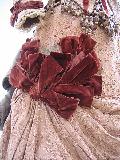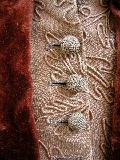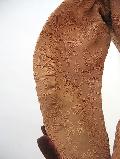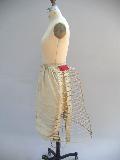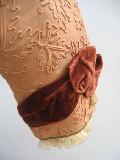Tan Bodice c.1886 - 1890
This bodice is part of a complete ensemble that includes the skirt, the bustle foundation, and a hat. The ensemble is made from silk sateen and has brown velvet trim and beaded fringe. These items were donated to the Costar Collection in the Department of Dramatic Art by Ms. Helen Tibbo. The ensemble originally belonged to Mrs. Isaiah Howes of Nantucket, Massachusetts. The label inside the garment says it originated from L.P. Hollander & Co. of Boston, Massachusetts.
Mrs. L.P. Hollander started the L.P. Hollander Company in 1848 in New York City. The company originally supplied children’s clothing and eventually focused on women’s wear. When her husband’s business failed she moved her family to Boston and opened the first L.P. Hollander store in 1886. The company catered to wealthy women and eventually opened stores in New York City; Paris, France; Newport, Rhode Island; and Pasadena, California.
It was originally believed that this dress dated to 1877 because of a stamp on the bustle dating March 6, 1877. This date may be when the bustle foundation originated but does not refer to the garment itself as the L .P. Hollander store in Boston did not open until 1886. Based in this information and the silhouette of the garment, the ensemble likely dates between 1886 and 1890. The bustle would have been used for many different dresses during the period. The silhouettes change from 1877 to 1886 but the many of the understructures remained the same. The addition of a bustle pad placed atop the bustle foundation itself created a larger silhouette as was seen at the end of the Bustle period.
Bodice
The bodice is made from silk sateen with cord embroidery in a leaf motif. Silk velvet ribbon parallels the center front and creates the outer collar, neck bow, sleeve decoration, and back bow. The bodice and sleeve hems have a bias flange made of silk faille that is visible by an 1/8 inch. There are sixteen hand-bound buttonholes down the center front with corresponding crocheted ball buttons. The neck and sleeve edges are finished off with a cotton net ruffle. The hem of the bodice is trimmed with hand-beaded fringe each ending with a pom-pom.
Construction
The construction of this bodice uses the same methods as other garments of the time. The silk sateen is flat-lined with cotton sateen. The flat-lining has a bust dart that is not present in the silk sateen layer. Two darts at the waist are used to create the waist shaping needed for a garment of this period. The front of the bodice is cut in one piece; the center front is self faced with the selvedge. The points at center front are weighted with fabric-covered weights.
The back is constructed in three pieces. The side seam finishes at the side under the arm and then kicks forward as you get to the hem of the bodice. The center back piece extends past the waist into tails, which consists of knife pleats one on top of the other; these pleats are cut in one with the center back. The pleats are lined with silk faille. The sleeves are cut in two pieces and flat lined. There is slight gathering at the elbow and the wrists have a vent. The hem is finished with a bias flange and netting gathered to a band. The left sleeve has been pieced together at the wrist. The velvet ribbon at the wrist is gathered and set into the front seam of the sleeve and finished in a bow.
The collar is faced with silk faille cut on the bias and hand sewn to the outer collar. The interior seams of the bodice are bound and finished by hand. Each seam has a bone stitched to the seam allowance. There is a label stitched into the waist of the bodice that reads L.P. Hollander & Co. Boston. Research revealed that this label originally was a waist tape. This waist tape would have been used to keep the bodice close to the corseted waist.
Condition
For a garment of this age there is very little damage to the bodice. The fabric has torn under the arms with more damage on the right side. There are also a few discoloration spots under the arms and a small green spot on the right shoulder. Hand stitching within some of the seams seems to indicate that stress may have damaged the seam integrity. The gatherings on the sleeves at the elbows have been hand sewn as a repair. One of the buttons at center front is missing.
© Randy Handley, 2010


